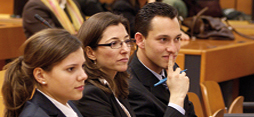

Archive
Short Course on Hologrammatic Terrorism Political violence in the communication society
The Course took place from 16 September to 22 September 20120 and was organized in cooperation with the Centre for Advanced Studies on Terrorism and Political Violence (Ce.A.S.) and the Scientific Park University Campus of Pomezia. The International Short Course on Hologrammatic Terrorism aimed to provide students and young professionals with a comprehensive understanding and a detailed perspective on communication, geopolitical and social aspects related to the problem and the evolution of terrorist groups in a globalized society.
While there is no universally accepted definition of terrorism, its motives or means, nor is there a clear line between terrorism and the legitimate use of violence, there is one commonly agreed-upon denominator: a symbiotic relationship linking terrorism and the media. In a modern society based on information, in which something “happens” only when it is reported by the media, terrorists are remarkably capable in exploiting mass media for propaganda: it is used to convey their messages, sponsor their causes and recruit new adepts, but also to influence political decision-making and public opinion. Terrorist propaganda seeks to mobilise domestic and international support, manipulating people’s suffering and creating a general sense of fear and vulnerability aimed at destabilising society and its institutions.
The more terrorist events are reported in the media, the more visibility and exposure they get. When a terrorist attack is broadcasted, it produces a series of media interference waves: the hologram of terrorism. Hologrammatic terrorism is a particular type of terrorism that completes the action and ingrains the image of its attack into the world. While it is technically not a holographic image in a strict sense, it lives in us and in our nightmares, making threats and risks that may not exist appear as real. This optical effect is useful to feed the social massive concern and to influence political decisions. The representation of terror is more efficient than its organization.
The programme covered the following topics:
- Strategies and methods of action in cyberspace;
- Creation and evolution of a net-learning-organization of terror;
- How terrorist groups use and exploit ICT technologies: from communications to virtual attacks passing through fund-raising activities;
- Terrorism prevention strategies;
- Understanding verbal and non-verbal messages of terrorist groups in web and media productions;
- Internet surveillance and challenges to the respect of civil rights and democracy.
The lecturers included international experts and distinguished members of ICTAC (International Counter-Terrorism Academic Community).



